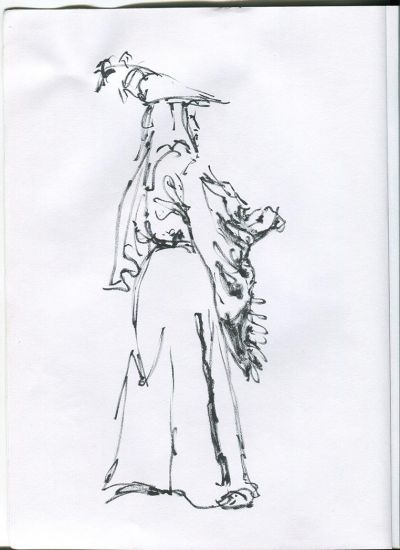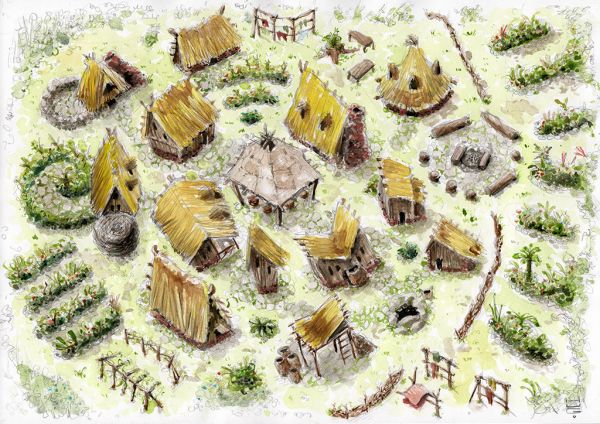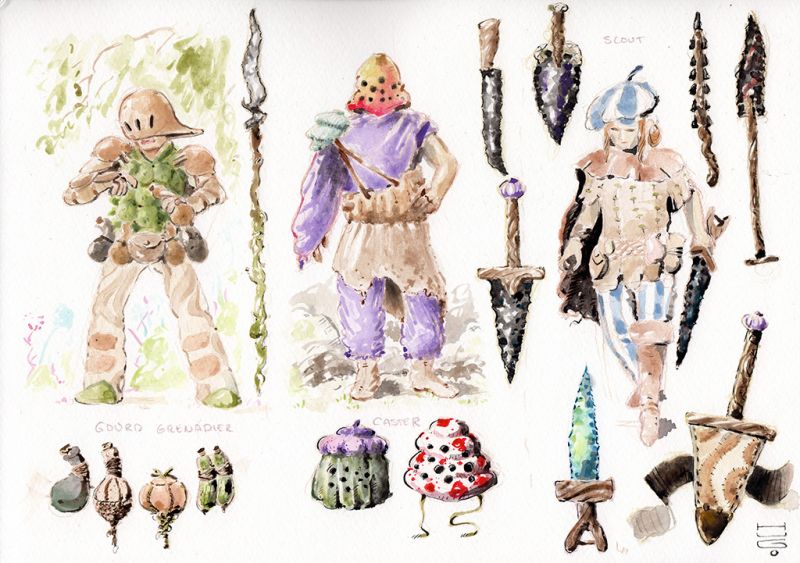Folk

Neo sapientes
One of the dominant Races on Lume, the Folk outwardly resemble the long extinct Forerunners. They boast a variety of pigmentation in combinations that appear to be erratic, so that an infant may sport hues not present in either parent. This happy occurrence has meant superficial prejudice is negligible among the Folk. Birth marks, heterochromia, and similar peculiarities are widespread, as are irises of yellow, sky blue, pink, mint green, violet, even pitch black. As an aside, there occurs more cases of albinism amongst Dunefolk, and mottled markings among the Druids; presumably a geographic adaptation, though further study is recommended.
The quintessential difference - and likely cause for the aforementioned idiosyncrasy - is the trait that entitles their race the genus neo. The neo sapientes are made things, created in much the same way as the other Races, Flora and Fauna of Lume; meaning they cannot claim ancestry over than their peers. As the Deumana came into power, they subordinated undesirable populations, who withered and eventually died off entirely. The ancient demigods later resurrected the human race, or something closely resembling them - by regressing samples of their own DNA, tampering and adjusting as they went along. Like the other playthings of the Deumana, these neo sapiens were made and unmade again, and again, and again. Perhaps something in this process - alonside their acceptance of being merely a part of the ecosystem around them, and not its master - has caused their cells to empathise with other elements on Lume at a molecular level. Their wavelengths are in sync with the matter the Deumana reconstructed; that is to say practically everything on the Continent. As such, all Folk are capable of causing said elements to shift, even change, if they have applied and devoted themselves to the practice of Casting. According to multiple historical accounts their creators' envy of this ability hastened, or even caused, the Schism. The Races all have their peculiarities: the Slenders exhibit great capacity for data retention and logic, the Manidae are strong and resilient, the Gardeners immortal and elemental, the Frost Giants wise and powerful, the Mytikos, Sui Generis and Cryptids each have their own unique features; the Folk have the capacity to Cast. This reason they should fear the invidiousness of the Deumana, regardless of whether the latter are alive, dead, or something else entirely.
Following the events of the Schism, the Folk bred proportionately throughout the Continent, depending on the resources available and the challenges they met. Thanks to the stewardship of the Frost Giants, Gardeners and in particular the Slenders, the Folk became a highly literate species, holding knowledge, and in particular wisdom, in high regard. It is reasonable to state that information and expertise are the greatest commodities in Lume, and serve as Currency. The common tongue is Barterspeak, though most peoples and Races have dialects or distinct languages of their own. Some cultures grew so divergent and independent they no longer consider themselves one of the Folk; the Druids and the Dunefolk are two examples. As all Folk respect knowledge, the accumulation of surplus goods and wealth is inherently abhorred, resulting in a strongly communal dynamic in their society.
The Folk are frank, friendly, and initially unassuming, right up until they start discussing the significance of beauty, truth and liberty, typically while performing an everyday task, such as carrying off an inconveniently placed log.
Hastille Village

Let us examine a typical Folk village from the Inland Forests. Ferns's home village is as good an example as any. Comprised of a handful of families and dozen or so separate individuals, this community is led by an elderly Mediator, with Fern's father gradually assuming the mantle. Two large barns stores their communal supplies, ringed by huts and cottages. Each dwelling has at least one garden, water barrel, latrine, and open-plan interior. The Architecture makes use of locally-sourced stone, wood, thatch, baked mud bricks, and gravel paths. Trogs help to keep wandering Fauna in line, and warn against danger. Mornings are spent hunter-gathering, cultivating the gardens and inspecting animals, the afternoons on constructive leisure; reading, gaming, writing, casting, crafting, constructing, exploring, and on cant and palaver. The village meets and trades with surrounding communities, offering opportunities for adolescents to meet. The resident Gardener is an aloof sort, spending their time tending elderly trees and entertaining the locals, for example by serving as an animated diving platform in the nearby river. Despite all this, the village is far from idyllic; people wander the forests and become lost, animals that wander freely don't always return. They have few resident Casters though lack a specialised healer; minor ailments are treated by Ferns's mother, while severe conditions require a journey to the witch Granny Moss. As with many Folk communities their proximity to a dense forest also leaves them vulnerable to attack from megafauna, cryptids, and worse, inducing them to develop Martial arts and tactics; staff-fighting and archery for preference. We leave this cross-section of typical Folk life to their contented but precarious existence.
Folk Warriors
The Grenadiers
These are specialised troops, leading the charge into villages that stubbornly resist the call to Empire. Outfitted with gourds that generate explosions, smoke, eye irritants, among other effects, they must throw hard, and far, to clear their comrades. Their attire is formed from molded, hardened gourds, Creeper hemp, leathery leaves, and various hides. The unregimented opponents they face also wield such munitions, though prefer peculiar concoctions using localised ingredients. A surprise in every one.
Casters
The magic users of Lume, having dedicated cycles to their particular School. The combatant Caster depicted here hails from the Elemental School - one of the most difficult to master - and sports a helm of tough fungi with viewing holes, to protect from backlashes when manipulating monad. These blunders are common, and fellow troops give them a good, wide berth.
The Scout
A soldier that is by necessity robust and adaptable, and the position a dangerous one. These wily, resourceful individuals are sent out into the untamed forests, riddled with wondrous critters, to spy a path for subsequent troops. They carry Sand-Casted obsidian blades, sharper than steel, and typically incorporate barks into their armor. This provides lightweight protection, and offers an easy occupation as they wait out dangers up a tree.
Aside a few atypical cases, mainland Folk do not distinguish themselves by location, cartography being still in its infancy. Trass sets about countering this, 'liberating' groups of people and conducting them into his empire. Hastille village is one such group. Towards the end of the Dead War the fledgling Empire splinters once again, though strong ties and grievances are maintained. Drethen & Co utilize this recent merging as a foundation to launch their Lyceum.

